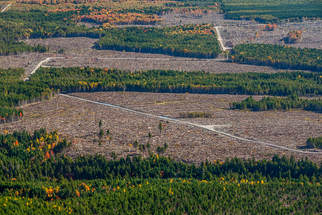
Every year roughly 13-15,000 hectares of New Brunswick’s Crown lands are sprayed with herbicides. Spraying takes place in clear-cuts that have been replanted with the softwood seedlings desired by the forestry industry. The purpose is to kill hardwood saplings—maples, birch, beech pin-cherry and poplar—and other grasses and weeds that compete with new plantings. Reducing the competition allows the plantation trees to grow faster.
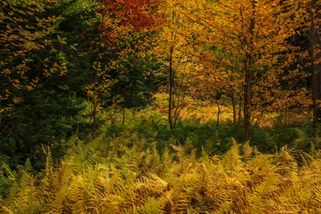 Herbicides kill the broadleaf trees and plants that give us the fall colour we love. Photo D. Carr
Herbicides kill the broadleaf trees and plants that give us the fall colour we love. Photo D. Carr Glyphosate kills all broadleaf plants it comes in contact with, including rare orchids, wildflowers, berries and other valuable vegetation that are food for many types of insects and wildlife. Diversity is essential for maintaining a healthy forest ecosystem.
New Brunswick uses more glyphosate than any other province except Ontario, and 30% of all Canadian forests sprayed with herbicide are in our province. The practice is destroying our valuable Acadian Forest, which is a unique ecosystem listed as one of six endangered forests in North America.
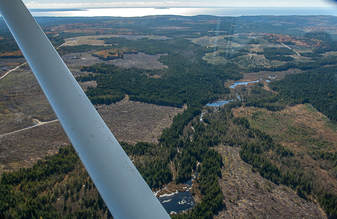 Clear-cuts frame a river along the Bay of Fundy Coast. Photo D. Carr
Clear-cuts frame a river along the Bay of Fundy Coast. Photo D. Carr According to a 2015 report by the Auditor General, Kim MacPherson, New Brunswick has lost about $7-$10 million dollars annually on its Crown forest resource between 2009 and 2014, largely due to this silviculture program. She also noted there is no evidence of any return or value to New Brunswickers as a result of this spending.
New Brunswick is the only province with a publicly-funded chemical spray program in its public forest. Nova Scotia no longer funds herbicide spraying and has stopped its use on crown lands; P.E.I. is pursuing Forest Stewardship Council certification for its public forest, which discourages herbicide spraying. Quebec banned herbicide spraying over a decade ago in 2001, citing potential health issues, habitat destruction and the job creation benefits of mechanical thinning.
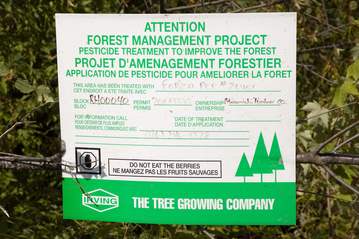
In 2015, the International Centre for Research on Cancer, a branch of the World Health Organization, classified glyphosate as probably carcinogenic. This year, California added glyphosate to its list of potentially cancer-causing chemicals.
Camp/cottage owners in spray areas have reported being advised to stay away from their properties on the day of application. Areas that are to be, or have been, sprayed are typically posted with signage that sometimes warn not to eat the berries, however, there are no such warnings for animals and birds that frequent the regions, nor can they be flushed from the site prior to spraying. A concerned citizen in the Miramichi area recently photographed a moose browsing on a plantation that had just been sprayed earlier in the day.
While Health Canada considers glyphosate safe if used in accordance with label instructions, a growing body of scientific research is raising serious concerns.
An article in the National Observer notes, “Studies done in France, the US, Brazil and Argentina have also linked the herbicide (glyphosate) to cancer, birth defects in frogs, and damage to human embryo and rat testicles.” A former research scientist with Agriculture Canada is quoted in the article as saying, “This fantasy that it does not affect animals, it's completely contradicted.”
Recent studies showed that 99.6% of the German population has glyphosate in their system. Swedish scientists have found that exposure to glyphosate is a risk factor for the development of non-Hodgkin lymphoma. Glyphosate, which is toxic to many beneficial micro- and macro-organisms including earthworms, also harms a wide range of microbes responsible for mineral uptake in soil. Glyphosate is retained and can be transported in soils, and in regions with long winters, this can have cumulative effects on the health and biology of the soil.
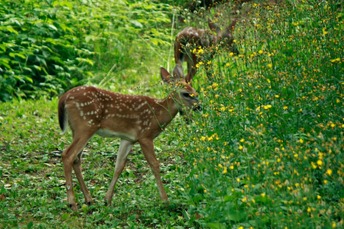 Young deer browsing on plants. Photo D. Carr
Young deer browsing on plants. Photo D. Carr Herbicides and deer populations
After a long and often hard winter, deer search out the tender new shoots of young saplings, their main summer food source. NB’s annual herbicide spray program removes enough of these saplings to feed approximately 26,000 deer per year. Some biologists believe this reduction in food and habitat has impacted the deer population, which is crashing; deer harvests dropped from 31,205 in 1985 to 4,378 in 2015. Meanwhile in Quebec, where the herbicide is banned, deer harvest tripled from 15,316 in 1985 to 47,629 in 2015. While the deer population is very visible, there has been little research on the impacts on other wildlife.
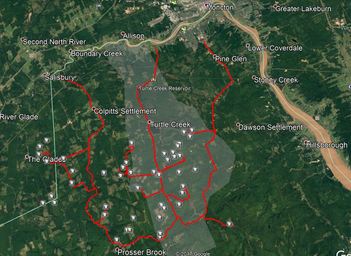 Sites to be sprayed within protected Turtle Creek watershed (indicated by white shading) in 2017. (Click image for larger viewing)
Sites to be sprayed within protected Turtle Creek watershed (indicated by white shading) in 2017. (Click image for larger viewing) Citizens are very concerned, particularly those in rural areas where the spraying takes place. In the previous ten years, four petitions have been submitted to the Province of NB to ban spraying in our forests. Number Five was delivered on May 18, 2016, with over 13,000 names of New Brunswickers who want the province to stop spraying public forests with glyphosate. To date, over 27,000 have signed the ongoing petition.
They are calling on the government to invoke the Precautionary Principle, which implies governments have a social responsibility to protect the public or environment from exposure to harm when science shows plausible risk. It states that when the health of humans and the environment are at stake, it isn’t necessary to wait for scientific certainty to take protective action, and so residents are asking for a moratorium on spraying herbicides, such as glyphosate, until an independent commission is able to determine its safety.
Meanwhile, the City of Moncton has expressed concerns over the plans of JDI Woodlands to spray sites within the Turtle Creek Watershed.
Get informed:
- Check the map showing the locations of proposed areas to be sprayed with herbicides in 2017 to see if areas near you will be sprayed this summer: http://geonb.snb.ca/herbicide/
- Visit Conservation Council of NB website for information and fact sheets: http://www.conservationcouncil.ca/en/our-programs/forest-conservation/ban-herbicides-now/
- Conduct your own research or visit the SSNB site for references: http://www.stopsprayingnb.ca/ref.html
Join the Movement:
Join the Stop Spraying New Brunswick Facebook page, which has almost 15,000 members. SSNB is a non-profit organization formed to unite citizens who are concerned about spraying in our province, and to share information on spray sites in the province.
- Facebook Site: https://www.facebook.com/groups/StopSprayinginNB/
- Website: http://www.stopsprayingnb.ca/
Use your Voice:
Write to your MLA and the Minister of Natural Resources to ensure your voice is heard. Never underestimate the power of individual letters. Every voice helps and your citizen complaint is never wasted. New Brunswick Environmental Network provides a tip sheet with research and facts vs myths that will help you write your letter: http://bit.ly/2vXr1JS
(Please note that the addresses in this document have changed. Access current names/addresses here: http://www1.gnb.ca/legis/bios/58/index-e.asp)
 RSS Feed
RSS Feed